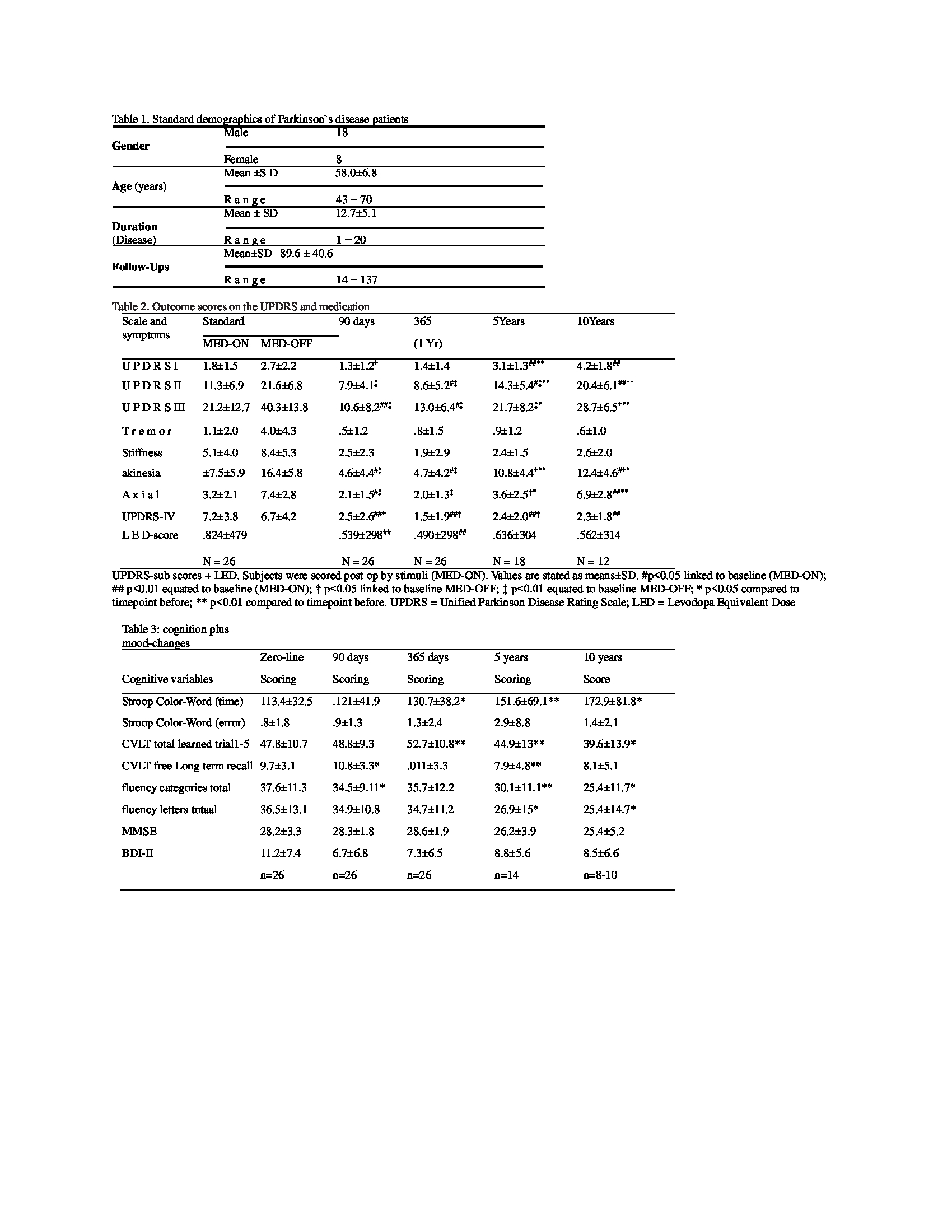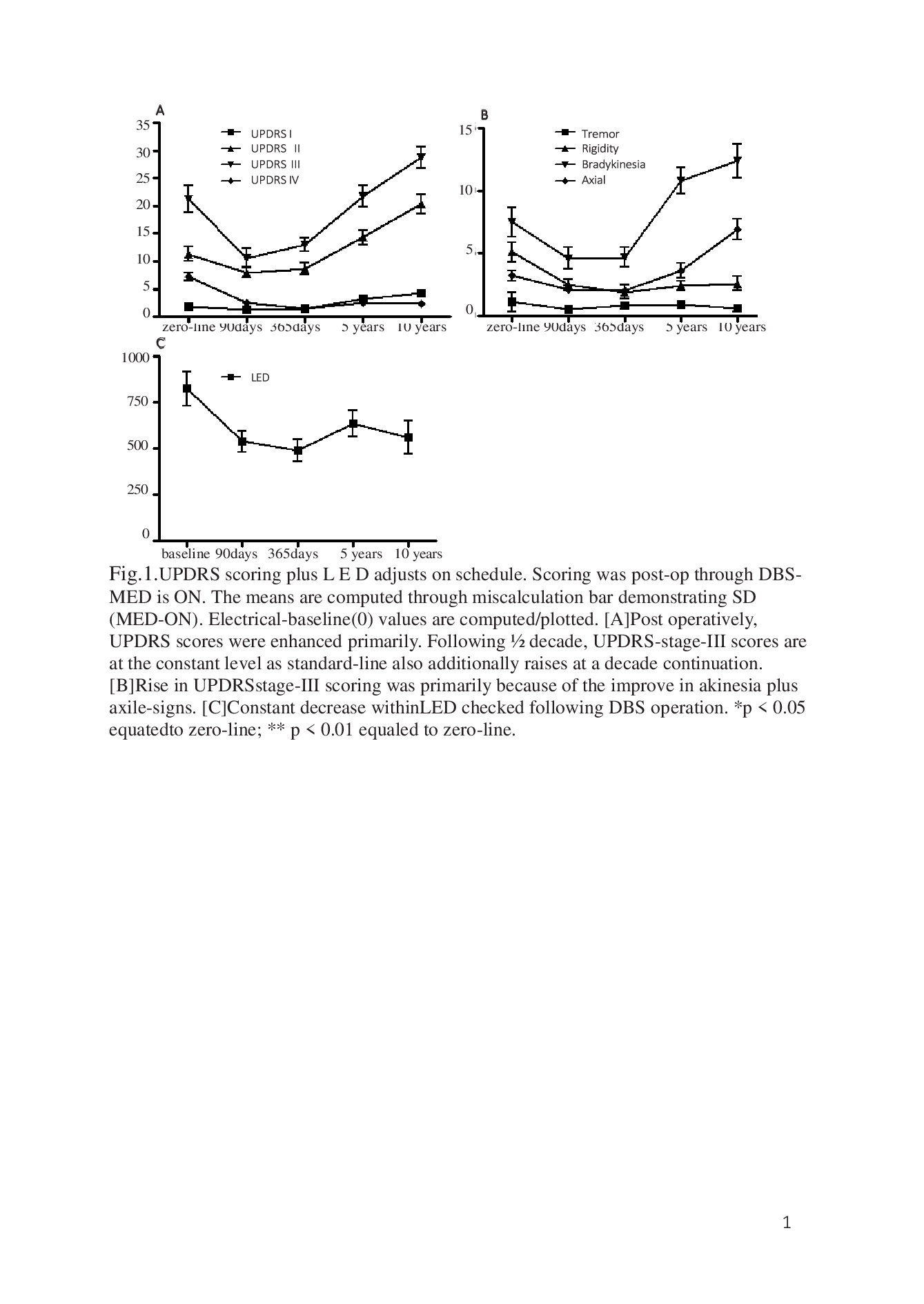Category: Parkinson's Disease: Pathophysiology
Objective:
To analyze the motoric and non-motoric symptoms of Parkinson`s following subthalamic-nuclei deep brain stimulations from a decade of follow-up study.
Background:
From the rudiment of STNDBS a myriad of experimental investigations has shown its efficacy. Yet, long-term follow-up studies are very few. This study discusses long-term follow ups.
Method: This databased cluster study describes the outcome of DBS in a cluster of twenty-six Parkinson`s, who were likely followed up ten-years after STN-DBS surgery. DBS was done a decade ago(28 patients), 2 were excluded from judgement (since erroneous data). 12 fulfilled the decade follow-up, yet 10 could achieve cognition checking-test(ON-DBS, Table 1, Parkinson`s features). The Levodopa equivalent dose (LED) was lowered instantly following surgery (32 %) 365days continuation (42 %) assessed to zero-line plus LED decrease chronic up to 10years follow up(Table2, demographics:Table1). Cycle of UPDRS stage/IV-score endured constant on ages, according to LED decrease. Cognition mood changes showed in Table 3.
The computation in Fig.1 is UPDRS scoring plus L E D adjusts on schedule. Scoring was post-op through DBS-MED is ON. The means are computed through miscalculation bar showing SD (MED-ON).Baseline-values are computed. [A]Post op, UPDRS scores were enhanced primarily. Following ½ decade, UPDRS-stage-III scores are at constant level as usual line also raises at a decade continuation. [B]Rise in UPDRSstage-III scoring was mainly despite the improve in akinesia, axial-signs. [C]Constant decrease withinLED checked following DBS operation. *p < 0.05 equatedto zero-line; ** p < 0.01 equaled to zero-line.
Results:
In the early post op phase progress on UPDRS-stage-III,IV (10.6,p<0.01, 2.5, p < 0.01) was envisioned, 32 % decrease within LED (p < 0.01). Then 5years motor functioning detected deteriorating despite worsening of akinesia(12.4 ± 4.6, p < 0.05) plus axile-signs( 6.9 ± 2.8, p <0.01 ). Recollection utility looked to progress over short-period, yet a substantial decrease amid 1,5 following surgery( p < 0.01). Patients feelings endured quite durable in sequel plus 1/3 patients proved spontaneous activities following the operation.
Conclusion:
Motoric functioning proven decline instantly synchronized, because of improve in akinesia plus axial signs and feature symptoms.
Standard demographics of patients
.UPDRS scoring plus L E D adjusts on schedule.
References: 1. Daniels, C., Krack, P., Volkmann, J., Pinsker, M. O., Krause, M., Tronnier, V., Kloss, M., Schnitzler, A., Wojtecki, L., Botzel, K., Danek, A., Hilker, R., Sturm, V., Kupsch, A., Karner, E., Deuschl, G., and Witt, K., 2010. Risk factors for executive dysfunction after subthalamic nucleus stimulation in Parkinson’s disease. Movement disorders : official journal of the Movement Disorder Society 25, 1583-1589.
2. Janssen, M. L., Zwartjes, D. G., Temel, Y., van Kranen-Mastenbroek, V., Duits, A., Bour, L. J., Veltink, P. H., Heida, T., and Visser-Vandewalle, V., 2012. Subthalamic neuronal responses to cortical stimulation. Mov Disord 27, 435-438.
3. Stefani, A., Lozano, A. M., Peppe, A., Stanzione, P., Galati, S., Tropepi, D., Pierantozzi, M., Brusa, L., Scarnati, E., and Mazzone, P., 2007. Bilateral deep brain stimulation of the pedunculopontine and subthalamic nuclei in severe Parkinson’s disease. Brain 130, 1596-1607.
4. Zangaglia, R., Pasotti, C., Mancini, F., Servello, D., Sinforiani, E., and Pacchetti, C., 2012. Deep brain stimulation and cognition in Parkinson’s disease: an eight-year follow-up study. Movement disorders : official journal of the Movement Disorder Society 27, 1192-1194.
To cite this abstract in AMA style:
L. Neerati, V. Raju, G. Ramaraju. Deep Brain Stimulators in Parkinson`s subthalamic nucleus: A Study of Decade Follow-Up [abstract]. Mov Disord. 2024; 39 (suppl 1). https://www.mdsabstracts.org/abstract/deep-brain-stimulators-in-parkinsons-subthalamic-nucleus-a-study-of-decade-follow-up/. Accessed May 12, 2025.« Back to 2024 International Congress
MDS Abstracts - https://www.mdsabstracts.org/abstract/deep-brain-stimulators-in-parkinsons-subthalamic-nucleus-a-study-of-decade-follow-up/


